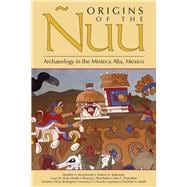
Note: Supplemental materials are not guaranteed with Rental or Used book purchases.
Purchase Benefits
What is included with this book?
| List of Figures | p. xi |
| List of Tables | p. xix |
| Preface | p. xxiii |
| Regional Study of Ancient Societies in the Mixteca Alta | p. 1 |
| Plan of the Book | p. 3 |
| Origins of Urbanism and the State | p. 4 |
| The Central Mixteca Alta | p. 5 |
| Survey | p. 15 |
| The Western Nochixtlán Valley | p. 29 |
| Jazmín | p. 30 |
| Nejapilla | p. 43 |
| Yodocono | p. 49 |
| Tidaá | p. 58 |
| Tilantongo | p. 63 |
| Sierra de Nochixtlán | p. 76 |
| Greater Teposcolula | p. 81 |
| Teposcolula | p. 82 |
| Nuñu | p. 96 |
| Yodobada | p. 109 |
| Yucunama | p. 117 |
| Lagunas | p. 126 |
| Yolomécatl | p. 137 |
| Nduayaco | p. 146 |
| Greater Huamelulpan | p. 157 |
| Yucuxaco | p. 158 |
| Huamelulpan | p. 165 |
| Tayata | p. 174 |
| The Inner Basin | p. 183 |
| San Juan Achiutda | p. 184 |
| Achiutda | p. 190 |
| Yucuañe | p. 202 |
| Tlacotepec | p. 210 |
| Amoltepec | p. 223 |
| Magdalena Peñasco | p. 230 |
| Dzinicahua | p. 243 |
| Greater Tlaxiaco | p. 255 |
| Tlaxiaco Valley | p. 256 |
| The Northeastern Periphery of Tlaxiaco | p. 267 |
| The Southeastern Periphery of Tlaxiaco | p. 272 |
| Nundichi/Ñumi | p. 279 |
| The Polities of the Early and Middle Formative | p. 285 |
| Aichaic | p. 285 |
| Early/Middle Cruz | p. 287 |
| Late Cruz | p. 290 |
| The Emergence of Urbanism and the State | p. 297 |
| Early Ramos | p. 297 |
| Late Ramos | p. 303 |
| The Classic Ñuu | p. 305 |
| The Postclassic Ñuu | p. 315 |
| The Ñuu in Anthropological Perspective | p. 331 |
| Survey | p. 331 |
| Formative Societies | p. 334 |
| The Ñuu and the State | p. 337 |
| Regional Abandonments | p. 345 |
| Agrarian Urbanism | p. 346 |
| Resumen en Español | p. 351 |
| Ceramic Chronology | p. 359 |
| Early/Middle Cruz | p. 360 |
| Late Cruz | p. 362 |
| Early Ramos | p. 368 |
| Late Ramos | p. 372 |
| Transición Las Flores | p. 372 |
| Early Las Flores | p. 376 |
| Late Las Flores | p. 379 |
| Natividad | p. 379 |
| Appendix 2: Flaked and Ground Stone | p. 387 |
| References Cited | p. 395 |
| Tables | p. 407 |
| Index | p. 501 |
| Table of Contents provided by Ingram. All Rights Reserved. |
The New copy of this book will include any supplemental materials advertised. Please check the title of the book to determine if it should include any access cards, study guides, lab manuals, CDs, etc.
The Used, Rental and eBook copies of this book are not guaranteed to include any supplemental materials. Typically, only the book itself is included. This is true even if the title states it includes any access cards, study guides, lab manuals, CDs, etc.